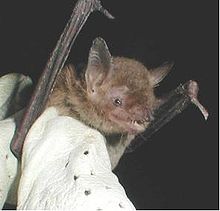
The gray bat is a species of microbat endemic to North America. The creature once flourished in caves all over the southeastern United States, but due to human disturbance, gray bat populations declined severely during the early and mid portion of the 20th century. 95% of gray bats now only roost in 11 caves. M. grisescens has been listed as federally endangered by the U.S. Fish and Wildlife Service since 1976, and is protected under the Endangered Species Act. Gray bat populations were estimated at approximately 2 million bats around the time they were placed on the Endangered Species list. By the early 1980s populations of gray bats dropped to 1.6 million. With conservation efforts in place, in 2004, gray bat populations were estimated to have reached 3.4 million.

The big brown bat is a species of vesper bat distributed widely throughout North America, the Caribbean, and the northern portion of South America. It was first described as a species in 1796. Compared to other microbats, the big brown bat is relatively large, weighing 15–26 g (0.53–0.92 oz) and possessing a wingspan of 32.5–35 cm (12.8–13.8 in). Big brown bats are insectivorous, consuming a diverse array of insects, particularly night-flying insects, but especially beetles. Some of the beetles it consumes are serious agricultural pests, including cucumber beetles. They are nocturnal, foraging for prey at night and roosting in sheltered areas during the day such as caves, tunnels, tree cavities, and human structures. Their breeding season is in the fall, shortly before their annual hibernation. After hibernation ends in the spring, females form maternity colonies for giving birth to young. Oftentimes only one offspring is produced per litter, though twins are common in the Eastern US. Lifespans of 6.5 years are considered average.
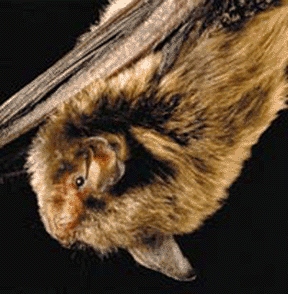
The Indiana bat is a medium-sized mouse-eared bat native to North America. It lives primarily in Southern and Midwestern U.S. states and is listed as an endangered species. The Indiana bat is gray, black, or chestnut in color and is 1.2–2.0 in long and weighs 4.5–9.5 g (0.16–0.34 oz). It is similar in appearance to the more common little brown bat, but is distinguished by its feet size, toe hair length, pink lips, and a keel on the calcar.

The pallid bat is a species of bat that ranges from western Canada to central Mexico. It is the sole species of its genus and is closely related to Van Gelder's bat, which is sometimes included in Antrozous. Although it has in the past been placed in its own subfamily (Antrozoinae) or even family (Antrozoidae), it is now considered part of the subfamily Vespertilioninae and the tribe Antrozoini.

The silver-tipped myotis is a species of mouse-eared bat found in a range of lowland habitats in the Americas.

Hodgson's bat, also called the copper-winged bat, is a species of vesper bat in the genus Myotis, the mouse-eared bats. Favouring mountain forests, it is found throughout Central, Southeast, and East Asia, from Afghanistan to the Japanese island of Tsushima. It is about 5 centimetres (2.0 in) long and is distinguished from most other species of bat in this range by its yellowish colouration.

The southeastern myotis is a small bat found throughout the Gulf Coastal Plain and the Lower Mississippi Alluvial Plain of the southeastern United States.
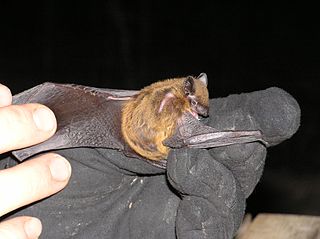
The evening bat is a species of bat in the vesper bat family that is native to North America. Hunting at night, they eat beetles, moths, and other flying insects.

The common noctule is a species of insectivorous bat common throughout Europe, Asia, and North Africa.

The greater mouse-eared bat is a European species of bat in the family Vespertilionidae.

The silver-haired bat is a solitary migratory species of vesper bat in the family Vespertilionidae and the only member of the genus Lasionycteris.

The eastern small-footed bat is a species of vesper bat. It can be found in southern Ontario and Quebec in Canada and in mountainous portions of the eastern United States from New England to northern Georgia, and westward to northern Arkansas. It is among the smallest bats in eastern North America and is known for its small feet and black face-mask. Until recently, all North American small-footed Myotis were considered to be "Myotis leibii". The western population is now considered to be a separate species, Myotis ciliolabrum. The Eastern small-footed bat is rare throughout its range, although the species may be locally abundant where suitable habitat exists. Studies suggest white-nose syndrome has caused declines in their populations. However, most occurrences of this species have only been counted within the past decade or two and are not revisited regularly, making their population status difficult to assess. Additionally, most bat populations in the Eastern U.S. have been monitored using surveys conducted in caves and mines in the winter, but Eastern small-footed bats hibernate in places that make them unlikely to be encountered during these surveys. Perhaps as a result, the numbers of Eastern small-footed bats counted in winter tend to be low and they are relatively variable compared to other species of bats. Many biologists believe the species is stable, having declined little in recent times, but that it is vulnerable due to its relatively restricted geographic range and habitat needs.

The fringed myotis is a species of vesper bat that is found in British Columbia, Mexico, and the western United States.

The long-legged myotis is a species of vesper bat that can be found in western Canada, Mexico, and the western United States.

The Yuma myotis is a species of vesper bat native to western North America.
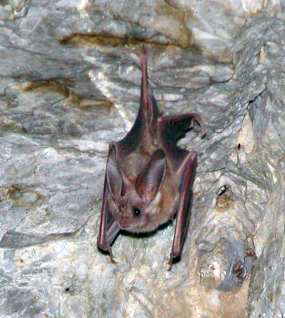
The California leaf-nosed bat is a species of bat in the family Phyllostomidae. It is found in Mexico and the United States. Its natural habitat is hot deserts. It is threatened by habitat loss.

The little brown bat or little brown myotis is a species of mouse-eared microbat found in North America. It has a small body size and glossy brown fur. It is similar in appearance to several other mouse-eared bats, including the Indiana bat, northern long-eared bat, and Arizona myotis, to which it is closely related. Despite its name, the little brown bat is not closely related to the big brown bat, which belongs to a different genus.
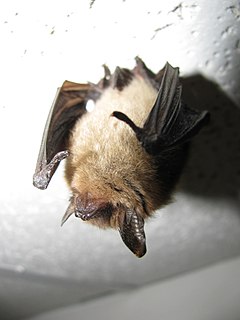
Myotis septentrionalis, known as the northern long-eared bat or northern myotis, is a species of bat native to North America. There are no recognized subspecies. The northern long-eared bat is about 3–3.7 inches in length, with a wingspan of 9–10 inches. It is distinguishable by its long ears when comparing it to other bats in its genus. This species is commonly found in the northern United States and Southern Canada east of British Columbia. The geographic range includes 37 states.

The California myotis is a species of vesper bat. It is found in British Columbia in Canada, Guatemala, Mexico, and in the western United States, including California.

A maternity colony refers to a temporary association of reproductive female bats for giving birth to, nursing, and weaning their pups. The colonies are initiated by pregnant bats. After giving birth, the colony consists of the lactating females and their offspring. After weaning, juveniles will leave the maternity colony, and the colony itself will break apart. The size of a maternity colony is highly variable by species, with some species forming colonies consisting of ten or fewer individuals, while the largest maternity colony in the world in Bracken Cave is estimated to have over 15 million bats.
